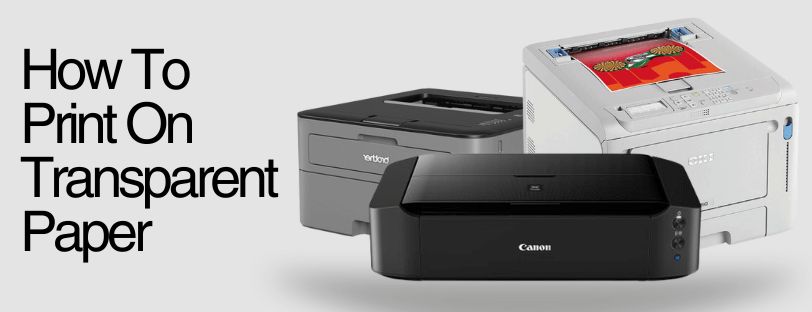
Printing on transparent paper can be a useful and creative way to bring your digital designs to life. Whether you’re working on a presentation, creating overhead slides for teaching, or producing transparencies for screen printing, understanding the proper techniques can make a significant difference in creating professional-looking results.
In this blog post, we’ll explain how to print on transparent paper and help master this creative art form.
Different Names For Transparent Paper
Transparent paper can go by a few different names depending on where they’re purchased from. Here is a list of the most common phrases.
- Acetate
- Transparencies
- Printable Film
Types Of Transparent Paper
It’s simple to understand the types of transparent sheets. There are two types, laser, or inkjet transparent sheets.
Overview Of The Different Types Of Transparent Paper
Inkjet Printer Transparency Paper
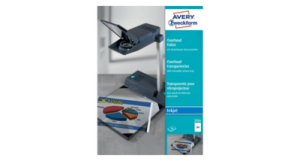 It’s key to ensure the Transparency sheets are suitable with your printer. Using an Inkjet Transparency sheet in a laser printer will cause the material to melt, as they are not made to withstand the higher temperatures in a laser printer.
It’s key to ensure the Transparency sheets are suitable with your printer. Using an Inkjet Transparency sheet in a laser printer will cause the material to melt, as they are not made to withstand the higher temperatures in a laser printer.
Laser Printer Transparency Paper
Laser printers arguably offer 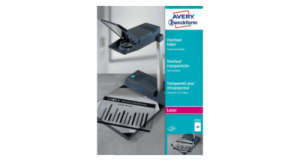 superior print quality for transparency. This is due to the heat regulation in the printers. However, it is vital to ensure the settings are correct for the media, to avoid melting the sheets and damaging the printer.
superior print quality for transparency. This is due to the heat regulation in the printers. However, it is vital to ensure the settings are correct for the media, to avoid melting the sheets and damaging the printer.
Laser printers have two options, a typical laser uses heat to apply the toner. Or an LED laser printer, which uses light. It is recommended to use LED laser printers to get the best print quality with the lowest risk of printer damage.
How To Print On Transparent Paper
Selecting suitable transparency paper is important for achieving high-quality prints. Make sure the sheets you purchase are designed for your printer type (inkjet or laser). Look for transparency paper with a coating for the printer you’ll be using, as this will improve the colour vibrancy, prevent smudging and avoid printer damage,
Before printing, make sure your design is prepared correctly. Start by creating or editing your design using applications like Adobe Photoshop, Illustrator, or Microsoft PowerPoint. Ensure that the dimensions of your design match the size of your transparency sheets to avoid any unwanted cropping or stretching during printing.
For the best results, configure your printer settings appropriately. Access your printer properties menu and select the transparency or acetate printing option. Adjust the print quality settings to the highest available resolution for clear and sharp images. Some printers may have specific transparency-related settings, such as drying time, so consult your printer’s manual for any additional recommendations.
Before printing your entire design, it is wise to perform a test print on a regular sheet of paper. This allows you to ensure that your design appears as intended and also helps in confirming the printer settings are accurate. Make any necessary adjustments to colour, brightness, or alignment before moving forward.
Transparency sheets are generally designed with a printable side and a non-printable side. Identify the printable side by checking for a rough or textured surface. Load the transparency sheets into the printer’s input tray, ensuring that you follow the recommended orientation specified by the manufacturer. Avoid overloading the tray to prevent paper jams.
Once you have successfully loaded the transparency sheets, you can start the printing process. Ensure that you have enough ink or toner for the entire job to avoid interruptions and allow the transparencies to dry fully before handling them to prevent smudging or smearing. For multi-page print jobs, wait for each transparency to dry before printing the next one.
Once the transparencies are dry, handle them with care to prevent fingerprints or scratches. If you plan to use them for overhead projections, place them in protective sleeves or store them in a clean, dust-free environment until needed.
Best Printers To Print On Transparent Paper
Oki C650 Best Printer for Transparencies
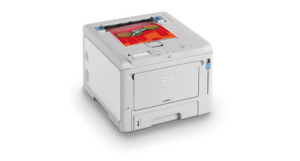
The Oki C650 is the best printer for marketing material, which goes together with transparency printing. Also, being an LED laser printer keeps the risk of melting materials minimal thanks to less heat used in the process.
With exceptional quality and durability and a 100-sheet multipurpose tray (Where the Transparency sheets can be loaded, this printer will have no problems printing all transparencies.
Brother HL-L2350DW Best Cheap Printer for Transparent Sheets
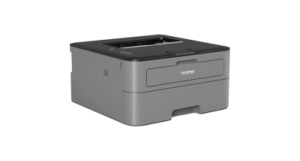 The Brother HL-L2350DW is a small, mono-laser printer. Designed for occasional use with black-and-white documents,
The Brother HL-L2350DW is a small, mono-laser printer. Designed for occasional use with black-and-white documents,
Featuring a single sheet Bypass Tray for 230gsm media, including laser transparency paper.
Canon PIXMA iX6850 Best Inkjet Printer for Acetate Sheets
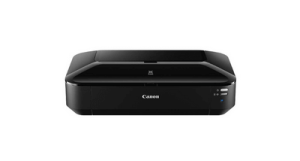 This A3 printer is designed around crafting and printing thicker media. For an inkjet, it offers brilliant quality on Transparent paper thanks to the mix of Dye and pigment-based blacks.
This A3 printer is designed around crafting and printing thicker media. For an inkjet, it offers brilliant quality on Transparent paper thanks to the mix of Dye and pigment-based blacks.
Canon PIXMA iP8750 Best Inkjet Printer for Transparencies & Crafting
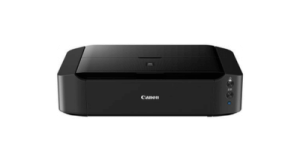 The successor to the Canon PIXMA iX6850 includes all the same features as the PIXMA iX6850 but includes a slightly higher quality and additional grey ink, alongside a higher purchase point.
The successor to the Canon PIXMA iX6850 includes all the same features as the PIXMA iX6850 but includes a slightly higher quality and additional grey ink, alongside a higher purchase point.
Problems With Transparency Printing
Ensure the transparencies are completely dry before handling them. Adjust printer settings to allow for more drying time if necessary.
Transparent paper sheets have a habit of blocking printers, this usually happens when printed through the main tray.
To combat this, print your sheets through the multipurpose feed/slot and keep to as few sheets in the tray as possible.
If you’re having colour or quality issues. A way to fix this would be to calibrate your printer and adjust colour settings in your design software. Check for printer driver updates to ensure optimal performance.
Make sure that your design is properly aligned with the software and that the transparency sheets are loaded correctly in the printer tray.
Summary
Printing acetate can boost your visual presentations, teaching materials, or even artistic projects to a whole new level. By following the steps outlined in this guide, you’ll know how to print on transparent paper. Remember to choose the right transparency sheets, adjust printer settings correctly, and handle the finished acetate with care.
Need Help or More Information ?
If you need any further help or more information, reach out to us by leaving a comment below or through one of the many ways on our Contact Us page. Alternatively you can contact us by Phone on 0161 308 5800 or by Live Chat on our main Website Monday to Friday and our team will be happy to help or answer with any questions you might have. You can also find all the various ways to connect with Us at the bottom of this page. Please share this post if you found it helpful.

